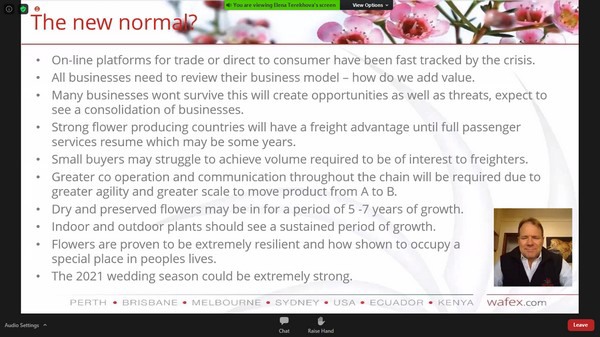How was last year, how are things now and what are the expectations for the future. In a virtual conference named "Recovery from Crisis - the future for ornamentals", AIPH brought together 30 expert speakers from 17 countries to share their experiences regarding the pandemic and the effects of this pandemic on their company and market and to shine more light on the future expectations and developments. The conference was a one-day event with a program divided in three main topics; Crisis Management, The future of cut flowers and the future of ornamental plants and trees. The majority of the presentations can be reviewed on their website, but below a summary of what was discussed.

The presentations were held in a virtual environment.
Crisis
The COVID-19 crisis, is the worst crisis in recent history and resulted in uncertainty in many sectors and periods. Particularly the months March and April were challenging. Entrepreneurs had to pull out all the stops to keep their businesses going or even keep them afloat. Split second decisions had to be made and the ones successful had proven to be resilient leaders. "A resilient leader is a leader that makes decisions with their heart and puts the mission first, aims for speed over elegance, owns the narrative and embraces the long view", explained Charlie Hall, Ellison Chair in International Floricutlrure, Texas A&M University, USA. He also stresses the importance of 'cash is key' and when looking at the shape of the economy recovery curve, it is correlated with the COVID-19 curve.
The crisis also resulted in an acceleration of several trends, as showcased at several presentations. Online sales, for example, skyrocketed worldwide. Also the trend 'back to nature' has grown even more, partly because a lot of people stayed at home and started to spend their time in the garden, also the younger generation. Besides that, the emphasis on health, both physically and mentally, increased, as well as the awareness of sustainability. Also the trend of consolidation returned. In March and April, there was a large dip in acquisitions, but in June and July there were more transactions than the year before. All in all, this year so far, there has been more take overs compared to the same period last year.

On top of presentations, there were also panel sessions being held. This one chaired by Eva Dahlqvist, Commercial Directer of Van Dijk Flora, together with Augusto Solano, President of Asocolflores (Colombia), Mr. Ryoji Kato of OTA Flower Auction Market (Japan), Kiki Fernandes, co-owner Marginpar and President of Kenya Flower Council and Clement Tulezi, CEO of Kenya Flower Council (Kenya)
Flower industry - past, present, future
We can probably all recall the images of the flower dumpings. Monday, March 16, for example, also called Black Monday by Steven van Schilfgaarde, CEO of Royal FloraHolland. Worldwide, the demand for flowers collapsed. Fortunately, this was for a relatively short period, particularly for the ones supplying the supermarkets. The florist started to go more online and started to up home deliveries. The event made business come to a complete (and still it is not running fully) standstill.
The demand started to rise and the next challenges arose. Are we allowed to continue growing our crop? Do we belong to the essential businesses? and so on. It took a lot of effort for the growers, companies and association to succeed, but nearly everywhere the industry was deemed essential. But how to get the flowers to the point of sale destinations? was the next question. In the US, for example, the trucks from the DCs to the supermarkets were completely filled with food, toilet paper and all other products that people were stocking. In the beginning of the crisis, there was literally no space for the flowers. Fortunately that recovered as well. The major problem, which is still a challenge, was the airfreight out of the producing countries like Kenya, Colombia and Ecuador to their export markets. The lack of capacity created high prices. The export associations did - and are still doing - all in their power to decrease the costs. At the same time, we saw an accelerated search for different transport options, like by ship.

Craig Musson, Managing Director WAFEX, Australia, spoke about his experience of running a large flower trading business from Australia and shared his predictions for the future.
Right before Mother's Day, the demand for flowers increased sharply and it has even been said that it has been the best July for the American importer. It gives hope for the future, but how will the demand develop when the situation turns to 'normal' again, so that people will go out more, so less at home and therefore less urge to brighten up their homes with flowers? It is also expected that there will come a recession, so a decrease in purchasing power. Will one still buy flowers or a bouquet? Many expect the demand is there to stay, but supplying quality remains essential. More people will work from home when the COVID-19 situation improves and when one has had a good experience with a bunch of flowers, they will more probably repeat the purchase. In addition, it is expected that 2021 will become a good wedding year as this year's weddings are being postponed. And what is a wedding without flowers?!
Plants and trees industry - past, present, future
Leaving out the climatologic difference between the northern and southern part of the country, the curve in the northern part of the world is more or less similar everywhere. For the garden plant sector, it has been a great season. Everywhere, people started to work from home, started to take care of their garden and the sales continued to rise, after spring and even in summer. And for autumn expectations are high as well. Like Abe van Wingerden, Co-CEO Metrolina Greenhouses (USA) said: "the demand is similar to how much we will grow. When we say 3%, it will be 3% and when we say 5 or 10, it will be 5 or 10." The demand has never been as high as it is now.
Worldwide demand
The end of the conference was all about the end consumer. How has the market changed, how are we going to persuade the consumer? From the Taipei Flower Market in Taiwan, out of the auction Veiling Holambra in Brazil, Val’hor in France and finally by Dennis van der Lubbe of Bloemenbureau Holland presented the strategies that, in their core, weren't different from what was told in the other presentations. "Cocooning" is expected to remain as well as working from home and social distancing. One is pleased with the conformation of being "essential" - in the Netherlands it even resulted in an emergency fund, but also in other countries one sees a demand that is being maintained. Also one loves to see the importance of the industry being stressed when talking about greening and sustainability.
AIPH conference
The presentations were held in a virtual 3D environment in which participants could visit different rooms with their own avatar. Additionally, the presentations could also be watched on Zoom.
For more information on AIPH and to see (a part of) the presentations: http://aiph.org/conference-2020/
 For more information:
For more information:
AIPH
Rachel Wakefield,
AIPH Communications Executive
Email: rachel.wakefield@aiph.org
Phone: +44 (0) 1235 776160
www.aiph.org
